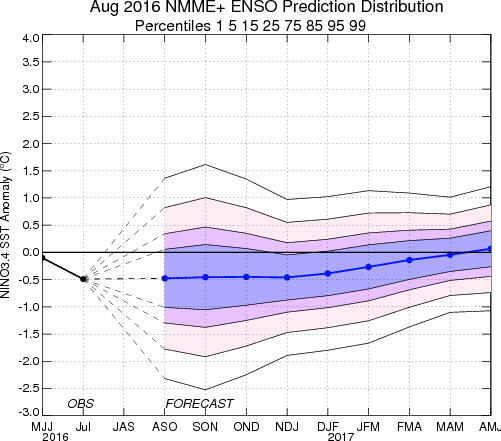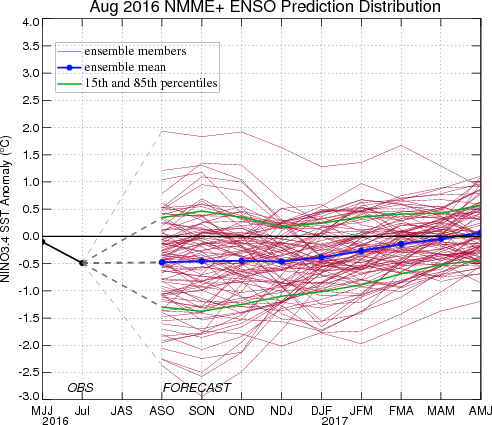IRI ENSO Forecast
IRI Technical ENSO Update and Model-Based Probabilistic ENSO Forecast
Published: August 18, 2016
Note: The SST anomalies cited below refer to the OISSTv2 SST data set, and not ERSSTv4. OISSTv2 is often used for real-time analysis and model initialization, while ERSSTv4 is used for retrospective official ENSO diagnosis because it is more homogeneous over time, allowing for more accurate comparisons among ENSO events that are years apart. During ENSO events, OISSTv2 usually shows stronger anomalies than ERSSTv4, and during very strong events the two datasets may differ by as much as 0.5 C.
Recent and Current Conditions
Since May 2016, ENSO-neutral conditions have prevailed. For July 2016 the average NINO3.4 SST anomaly was -0.49 C, indicative of neutral ENSO conditions but close to the threshold for weak La Niña conditions. For May-Jul it was -0.10 C, in the ENSO-neutral category. The IRI’s definition of El Niño, like NOAA/Climate Prediction Center’s, requires that the SST anomaly in the Nino3.4 region (5S-5N; 170W-120W) exceed 0.5 C. Similarly, for La Niña, the anomaly must be -0.5 C or less. The climatological probabilities for La Niña, neutral, and El Niño conditions vary seasonally, and are shown in a table at the bottom of this page for each 3-month season. The most recent weekly anomaly in the Nino3.4 region was -0.6 at a weak La Niña level. However, accompanying this ocean condition, a generally neutral condition is observed in the atmosphere, including weak lower-level wind anomalies, and convection anomalies across the equatorial Pacific that are only weakly suggestive of La Niña so far. The Southern Oscillation Index (SOI) and the equatorial SOI have been just weakly positive, leaning toward La Niña but still in La Niña territory. Overall, neutral ENSO conditions are still indicated.
Expected Conditions
What is the outlook for the ENSO status going forward? The most recent official diagnosis and outlook was issued one week ago in the NOAA/Climate Prediction Center ENSO Diagnostic Discussion, produced jointly by CPC and IRI; it called for a roughly 55-60% likelihood of La Niña during fall and winter 2016-17. The latest set of model ENSO predictions, from mid-August, now available in the IRI/CPC ENSO prediction plume, is discussed below. Currently, the Nino3.4 SST anomalies are at the level of minimal La Niña. Subsurface temperature anomalies across the eastern equatorial Pacific continue to be somewhat below average. Although enhanced easterly trade winds have not yet been observed, the slightly below-average SSTs and the negative subsurface heat content anomaly is a good backdrop for the onset of such enhanced trades in the eastern tropical Pacific. When and if these develop, the SST is likely to fall further into to weak La Niña category by late August or September, and if this happens the La Niña condition would likely last, even if only weak, through the remainder of the year. However, the collection of the latest model predictions suggest that this scenario is only slightly more likely than not to happen.
As of mid-August, 52% of the dynamical or statistical models predicts La Niña conditions for the initial Aug-Oct 2016 season, while 48% predict neutral ENSO. At lead times of 3 or more months into the future, statistical and dynamical models that incorporate information about the ocean’s observed subsurface thermal structure generally exhibit higher predictive skill than those that do not. For the Nov-Jan 2016-17 season, among models that do use subsurface temperature information, 35% predicts ENSO-neutral conditions and 65% predicts La Niña conditions. For all model types, the probabilities for La Niña are between 50% and 60% from Aug-Oct 2016 through Nov-Jan 2016-17, near 45% for Dec-Feb and Jan-Mar 2017, and drop back below 40% beginning in Feb-Apr 2017. No model predicts El Niño for any of the periods forecast.
Note – Only models that produce a new ENSO prediction every month are included in the above statement.
Caution is advised in interpreting the distribution of model predictions as the actual probabilities. At longer leads, the skill of the models degrades, and skill uncertainty must be convolved with the uncertainties from initial conditions and differing model physics, leading to more climatological probabilities in the long-lead ENSO Outlook than might be suggested by the suite of models. Furthermore, the expected skill of one model versus another has not been established using uniform validation procedures, which may cause a difference in the true probability distribution from that taken verbatim from the raw model predictions.
An alternative way to assess the probabilities of the three possible ENSO conditions is more quantitatively precise and less vulnerable to sampling errors than the categorical tallying method used above. This alternative method uses the mean of the predictions of all models on the plume, equally weighted, and constructs a standard error function centered on that mean. The standard error is Gaussian in shape, and has its width determined by an estimate of overall expected model skill for the season of the year and the lead time. Higher skill results in a relatively narrower error distribution, while low skill results in an error distribution with width approaching that of the historical observed distribution. This method shows probabilities for La Niña at 53% for Aug-Oct 2016, rising slightly to a maximum of 58% for Nov-Jan 2016-17, and remaining above 50% through Jan-Mar. Probabilities for El Niño are 5% or lower throughout the forecast period ending in Apr-Jun 2017. Probabilities for ENSO-neutral exceed 50% beginning in Feb-Apr 2017. A plot of the probabilities generated from this most recent IRI/CPC ENSO prediction plume using the multi-model mean and the Gaussian standard error method summarizes the model consensus out to about 10 months into the future. The same cautions mentioned above for the distributional count of model predictions apply to this Gaussian standard error method of inferring probabilities, due to differing model biases and skills. In particular, this approach considers only the mean of the predictions, and not the total range across the models, nor the ensemble range within individual models.
In summary, the probabilities derived from the models on the IRI/CPC plume describe, on average, a likelihood for La Niña conditions of greater than 50% from Aug-Oct through early 2017, but never more than about 55-60% during fall through mid-winter 2016-17. A caution regarding this latest set of model-based ENSO plume predictions, is that factors such as known specific model biases and recent changes that the models may have missed will be taken into account in the next official outlook to be generated and issued in early October by CPC and IRI, which will include some human judgement in combination with the model guidance.
Climatological Probabilities
| Season |
La Niña |
Neutral |
El Niño |
| DJF |
36% |
30% |
34% |
| JFM |
34% |
38% |
28% |
| FMA |
28% |
49% |
23% |
| MAM |
23% |
56% |
21% |
| AMJ |
21% |
58% |
21% |
| MJJ |
21% |
56% |
23% |
| JJA |
23% |
54% |
23% |
| JAS |
25% |
51% |
24% |
| ASO |
26% |
47% |
27% |
| SON |
29% |
39% |
32% |
| OND |
32% |
33% |
35% |
| NDJ |
35% |
29% |
36% |

IRI/CPC Mid-Month Model-Based ENSO Forecast Probabilities
| Season |
La Niña |
Neutral |
El Niño |
| ASO 2016 |
53% |
47% |
0% |
| SON 2016 |
54% |
43% |
3% |
| OND 2016 |
56% |
39% |
5% |
| NDJ 2016 |
58% |
37% |
5% |
| DJF 2017 |
56% |
39% |
5% |
| JFM 2017 |
53% |
43% |
4% |
| FMA 2017 |
44% |
53% |
3% |
| MAM 2017 |
37% |
60% |
3% |
| AMJ 2017 |
35% |
61% |
4% |





